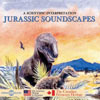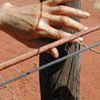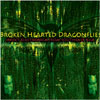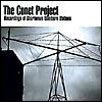 Your mission, should you choose to accept it, is to create an album of imagined “field recordings” of dinosaurs. Simple enough? OK, now comes the hard part – get an eminent international sound library devoted to the very serious task of collecting “natural sound sceneries of endangered ecosystems” to release it.
Your mission, should you choose to accept it, is to create an album of imagined “field recordings” of dinosaurs. Simple enough? OK, now comes the hard part – get an eminent international sound library devoted to the very serious task of collecting “natural sound sceneries of endangered ecosystems” to release it.
On the face of it, this might seem like a challenge that would fail at the first pitch meeting, but somehow sound recordist Jean-Luc Herelle managed to pull it off with Jurassic Soundscapes, an album of the speculative sounds of these long extinct beasts which was released on the very "serious" Fremeaux & Associes label. (In the liner notes, however, Fremeaux’s head honcho does admit that it “may at first sight appear to be a little ridiculous”.)
What no doubt helped Herelle get this past any furrowed brows at Fremeaux is the fact that he’s got reputable expert opinion on his side. He's consulted paleontologists who’ve given him the low down on the resonant qualities of the morphologies of various dinosaurs and pointed out that dinosaurs are ancestors of modern-day birds. So Herelle, who’s made a career out of recording birds, has pulled out some of his old master tapes, pitch-shifted them down, remixed them, and – hey presto! – he gives us the sounds of paddling plesiosaurs, chattering archaeopteryxes, and growling tyrannosaurs. Here are some samples:
Excerpt #1 – Plesiosaurs and Rhamphorhynchues at a Triassic lakeside (200 million BC)
Excerpt #2 – A Tyrannarosaurus growls during a late Cretaceous storm (64 million BC)
Regardless of how accurate these are (and we won’t know that till we can punch a wormhole into the Jurassic and send in a binaural mike) the album’s a great guilty “field recording” pleasure and you can purchase it from Aquarius Records or Audio Roots.
 For the past seven year, Christopher DeLaurenti has been turning up to classical concerts in a leather vest with concealed microphones attached to a minidisc recorder. The goal of this clandestine bootlegging setup has not been to record any music that was on the programme, but rather to capture what happened during intermission. While other concert-goers were off sipping bubbly and relieving their bladders, he was there in the front row documenting the sound of milling patrons and orchestra members rehearsing their parts. In the process, he discovered an entirely "new", and previously undocumented, form of “improvised” music.
For the past seven year, Christopher DeLaurenti has been turning up to classical concerts in a leather vest with concealed microphones attached to a minidisc recorder. The goal of this clandestine bootlegging setup has not been to record any music that was on the programme, but rather to capture what happened during intermission. While other concert-goers were off sipping bubbly and relieving their bladders, he was there in the front row documenting the sound of milling patrons and orchestra members rehearsing their parts. In the process, he discovered an entirely "new", and previously undocumented, form of “improvised” music.
Musicians left on stage during intermission would generally use the time to practice difficult passages from the pieces to come. For the most part, they would twiddle away obliviously but occasionally they would latch on to what was being played in another section of the orchestra. This might continue for a few bars then fall apart and be replaced by cacophony followed by another spontaneous coming together around a new passage – kind of like a random sheet-music based version of one of John Zorn’s improvisational music games.
DeLaurenti’s obsessive documentation of these moments of interstitial orchestral "improvisation" has resulted in 50 hours worth of recordings which he has condensed into a single CD of “greatest hits” entitled Favourite Intermissions. The CD can be purchased from his website. Here’s a track from it called SF Variations (I think that’s short for Stravinsky’s Firebird… But I could be wrong about that. Any ideas?)
 It’s always nice to get emails from other mp3 bloggers, especially when they’re ones who are doing unusual things with the medium. Wolfgang Dorniger is an Austrian sound artist with a passion for field recordings who uses his blog to post just that – field recordings of ships, car washes, bus rides, church interiors and so on. Some of them he uses in his works, some of them are just interesting documents of environmental sounds. All of them are available as a podcast.
It’s always nice to get emails from other mp3 bloggers, especially when they’re ones who are doing unusual things with the medium. Wolfgang Dorniger is an Austrian sound artist with a passion for field recordings who uses his blog to post just that – field recordings of ships, car washes, bus rides, church interiors and so on. Some of them he uses in his works, some of them are just interesting documents of environmental sounds. All of them are available as a podcast.
 In 1977, sound artist Bill Fontana took a tape recorder down to the Kirribilli ferry pier in Sydney Harbour and discovered “music” in the sounds of the waves sluicing water into bore holes on the dock. (You can hear samples of it in this Quicktime video on his site.) The recording eventually reached the ears of artist in residence at the San Francisco Exploratorium, Peter Richards, and he sought to emulate this wave-produced music by embedding PVC and concrete pipes into a jetty on San Francisco Bay; at heights where they could be reached by the incoming tide. He called this creation, the Wave Organ. Unfortunately, I haven’t managed to track down any online audio of the Wave Organ in action, but reporter Megan Edwards describes it as “like listening to the world's largest sea shell. It's like distant drums, muffled cymbals, quiet thunder.”
In 1977, sound artist Bill Fontana took a tape recorder down to the Kirribilli ferry pier in Sydney Harbour and discovered “music” in the sounds of the waves sluicing water into bore holes on the dock. (You can hear samples of it in this Quicktime video on his site.) The recording eventually reached the ears of artist in residence at the San Francisco Exploratorium, Peter Richards, and he sought to emulate this wave-produced music by embedding PVC and concrete pipes into a jetty on San Francisco Bay; at heights where they could be reached by the incoming tide. He called this creation, the Wave Organ. Unfortunately, I haven’t managed to track down any online audio of the Wave Organ in action, but reporter Megan Edwards describes it as “like listening to the world's largest sea shell. It's like distant drums, muffled cymbals, quiet thunder.”
More recently, this concept of a wave-driven instrument was incorporated into the 2005 refurbishments of the quay at Zadar in Croatia. This version, called the Sea Organ, consists of a series of whistle openings built into the steps of a promenade that descends into the Adriatic. Unlike, the Wave Organ, the dulcet tones of the Sea Organ have been well documented in YouTube videos, a downloadable mp3, and a CD that can purchased from the official site.
(via Neatorama and Metafilter)
 Here’s a blog for anyone who ever had a radio cassette with shortwave bands and spent hours reveling in the sound of exotic transmissions appearing from then being ripped apart by waves of static and pulsing interference tones. Its put together by sound artist Myke Weiskopf, who lovingly records and posts these corrupted transmissions, and has even brought out an CD with some of them on it. (via Sound Scavengers)
Here’s a blog for anyone who ever had a radio cassette with shortwave bands and spent hours reveling in the sound of exotic transmissions appearing from then being ripped apart by waves of static and pulsing interference tones. Its put together by sound artist Myke Weiskopf, who lovingly records and posts these corrupted transmissions, and has even brought out an CD with some of them on it. (via Sound Scavengers)
 And now a very special field recording captured by a group of German scientists from the Alfred Wegener Institute for Polar and Marine Research while recording seismic signals in the Antarctic. It’s the sound of a massive 50 by 20km iceberg slowly grinding its way over a submerged outcrop in the seabed. Normally, this is a sound that would go unheard by human ears, as the frequencies occupy a register far lower than what is audible to us (around 0.5 hertz apparently). But the scientists have sped it up so we are able to hear this geological event unfold for the first time. (via WFMU)
And now a very special field recording captured by a group of German scientists from the Alfred Wegener Institute for Polar and Marine Research while recording seismic signals in the Antarctic. It’s the sound of a massive 50 by 20km iceberg slowly grinding its way over a submerged outcrop in the seabed. Normally, this is a sound that would go unheard by human ears, as the frequencies occupy a register far lower than what is audible to us (around 0.5 hertz apparently). But the scientists have sped it up so we are able to hear this geological event unfold for the first time. (via WFMU)
 Its taken a while for me to get my hands on this double CD but the wait has well and truly been worth it… Shipwreck Radio is a series of seven manipulated-sound radio broadcasts that were produced by Stephen Stapleton and Colin Potter of Nurse With Wound as part of a two month marooning-for-arts-sake in a tiny fishing village on the Lofoten Islands, just off the coast of far-northern Norway.
Its taken a while for me to get my hands on this double CD but the wait has well and truly been worth it… Shipwreck Radio is a series of seven manipulated-sound radio broadcasts that were produced by Stephen Stapleton and Colin Potter of Nurse With Wound as part of a two month marooning-for-arts-sake in a tiny fishing village on the Lofoten Islands, just off the coast of far-northern Norway.
They arrived there in June 2004 with minimal equipment and were instructed to produce three programmes a week on the local radio station using only sounds recorded in their wanderings around the islands. And so they ventured out, capturing the sounds you might expect to find in an arctic fishing village – ships, seabirds, the mutterings of fishermen, the cracking of receding ice. But in their travels they also encountered the unexpected – a festival of marching bands called “Codstock”, locals enthusing over the Grateful Dead, and a community of Namibian refugees.
Back in the studio, these sounds were treated and layered to produce slow-burn digitised soundscapes (and the occasional slab of strident breakbeat) that became increasingly mangled and malformed as the never-setting sun began to take its toll on the circadian rhythms of Stapleton and Potter…
On the show today, we featured this condensed remix of the “breakbeat” broadcast from June 15. Its fairly atypical of the album so I’ll also post this remix of the sleep-deprived-hallucination cum audio-travelogue that was broadcast on June 17. It really doesn’t do it justice – but I don’t have the space to post the complete 30 minute version…
If you like what you hear, you might still be able to pick up a copy from Aquarius Records, or you can visit the site of distributor, ICR Distibution. They don’t have any copies of the CDs available for sale on their own, but you can pick it up as part of a double set which features Volume 2 of Shipwreck Radio (which has only just been released)
 In 1982, two kids with a Sony Walkman recorder became obsessed with recording the sounds of the their local video arcade in Ithaca, NY. The obsession continued for the next six years, resulting in fourteen tapes worth of bleeps, blasts and cheesy eight-bit game music. At the time, the idea of recording this stuff probably would have earned the pair tragic nerd status, but now, with the all the rampant nostalgia for the eight-bit eighties, these recordings can proudly take their place on the web as a important audio document of the “good old days” of arcade gaming. (via Metafilter)
In 1982, two kids with a Sony Walkman recorder became obsessed with recording the sounds of the their local video arcade in Ithaca, NY. The obsession continued for the next six years, resulting in fourteen tapes worth of bleeps, blasts and cheesy eight-bit game music. At the time, the idea of recording this stuff probably would have earned the pair tragic nerd status, but now, with the all the rampant nostalgia for the eight-bit eighties, these recordings can proudly take their place on the web as a important audio document of the “good old days” of arcade gaming. (via Metafilter)
(FOOTNOTE: Not only is there a great assortment of ambient game sounds to wallow in, but on their recording of Defender you get this priceless response to an attendant asking if they were recording the machine: “Yeah…Not for reproductive purposes…”)
Post-contact outback Australia is a land that has been divvied up and delineated by wires – wires nailed to fence-posts to mark out properties; wires strung atop poles to deliver power and telecommunications. If you’ve spent any time driving through it, these wires (and the road under your wheels) are often the only discernable reminders of the European conquest of this sparsely populated continent. (Until, of course, you come across the inevitable roadhouse/internet café in the middle of nowhere.)
So, its somehow appropriate that the two artists who have been most active in exploiting the musical potential of such long-span wires, are both Australian.
 First up is Alan Lamb, who records the sounds made by telegraph wires as they vibrate in the wind. He started doing this in the late 80’s, after acquiring a property near Fitzgerald National Park in southern Western Australia, that was traversed by these wires. The recordings he made were done by attaching contact mikes to the wires and waiting for the wind to set them in motion. The results are an eerie mix of glacially surging tones and slow-motion laser gun blasts. Here’s a remixed sample from his 1995 CD, Archival Recordings.
First up is Alan Lamb, who records the sounds made by telegraph wires as they vibrate in the wind. He started doing this in the late 80’s, after acquiring a property near Fitzgerald National Park in southern Western Australia, that was traversed by these wires. The recordings he made were done by attaching contact mikes to the wires and waiting for the wind to set them in motion. The results are an eerie mix of glacially surging tones and slow-motion laser gun blasts. Here’s a remixed sample from his 1995 CD, Archival Recordings.
 Unlike Lamb, who passively records the sounds produced by wires, avant-garde violinist Jon Rose seeks out continent-spanning barriers like the rabbit proof fence, and hammers and saws tones out of them with help of violin and cello bows. Where Lamb’s recordings surge and spike, Rose’s rattle and splinter. Here’s a sample recorded on the perimeter fence of a communications site near Alice Springs. Its taken from the CD, Great Fences of Australia (which was released with a complimentary piece of barbed wire.)
Unlike Lamb, who passively records the sounds produced by wires, avant-garde violinist Jon Rose seeks out continent-spanning barriers like the rabbit proof fence, and hammers and saws tones out of them with help of violin and cello bows. Where Lamb’s recordings surge and spike, Rose’s rattle and splinter. Here’s a sample recorded on the perimeter fence of a communications site near Alice Springs. Its taken from the CD, Great Fences of Australia (which was released with a complimentary piece of barbed wire.)
 With massive solar storms causing the polar aurora to venture far into temperate skies, now seemed like the perfect time to post these sites set up by boffins who use Very-Low-Frequency radio receivers to produce audio portraits of the EMF emissions that seethe through this planet's atmosphere.
With massive solar storms causing the polar aurora to venture far into temperate skies, now seemed like the perfect time to post these sites set up by boffins who use Very-Low-Frequency radio receivers to produce audio portraits of the EMF emissions that seethe through this planet's atmosphere.
Over at NASA, they have an audio stream of sounds picked up by their VLF receiver in Huntsville, Alabama. By and large, they emanate from far off thunderstorms that produce a lovingly categorised array of noises with names likes sferics, tweeks and whistlers. (via Web Zen)
Stephen McGreevy also records low-frequency atmospheric sounds but he heads out into the action; monitoring the aurora borealis in Northern Alberta, or travelling to RF noise free environments like Death Valley to capture “whistler showers”. He has a wide variety of sound files of recordings from these field trips on his website, and also has CDs for sale.
 There will no doubt be much better records that come out this year – records that rock your world; that restore your flagging faith in the life-affirming power of music; and so on… But nothing will slap your preconceptions about “music” in the face quite like this new release from Sublime Frequencies….
There will no doubt be much better records that come out this year – records that rock your world; that restore your flagging faith in the life-affirming power of music; and so on… But nothing will slap your preconceptions about “music” in the face quite like this new release from Sublime Frequencies….
If you were to listen to it without being told anything about its creators, you might think that it was the latest work by some European or Japanese drone-n-sine-tone electronica artist… Or you might pick that its sourced from field recordings, but conclude that its been heavily processed, sequenced and composed… But its none of these…
Supposedly, it’s a series of unprocessed field recordings of swarming insects recorded by Tucker Martine in Thailand, Myanmar and Laos. The title of the album refers to a Burmese folk-story which claims that these are the sounds of the hearts of post-coital male dragonflies bursting from their chests… Something which seems entirely plausible when you hear the "orchestrated" insect shriek crescendos in this excerpt from Morning Fanfare...
If want more, you can purchase the album from the Sublime Frequencies website.
 The Conet Project is a landmark 4 CD set that documents the intriguing phenomena of “numbers stations”- shortwave transmissions of voices endlessly reciting sequences of numbers which apparently served as coded messages for Cold War era spies. It was originally released in the late 90’s and, in 2002, a sizable chunk (1 min 3sec) of one of its recordings ended up in a track on the universally acclaimed album Yankee Hotel Foxtrot by Wilco. (The name of that album is taken from a Conet Project track which featured a woman repeating this phrase.) In response, Irdial sued Wilco’s label, WEA, for breach of copyright and, in June this year, they received a healthy settlement from the “infringing” major label.
The Conet Project is a landmark 4 CD set that documents the intriguing phenomena of “numbers stations”- shortwave transmissions of voices endlessly reciting sequences of numbers which apparently served as coded messages for Cold War era spies. It was originally released in the late 90’s and, in 2002, a sizable chunk (1 min 3sec) of one of its recordings ended up in a track on the universally acclaimed album Yankee Hotel Foxtrot by Wilco. (The name of that album is taken from a Conet Project track which featured a woman repeating this phrase.) In response, Irdial sued Wilco’s label, WEA, for breach of copyright and, in June this year, they received a healthy settlement from the “infringing” major label.
All of which has raised a certain amount of ire in online “information-wants-to-be-free” circles. After all, how can one claim copyright in recordings taken straight from radio stations?... If you’re in America, it seems you can’t – the simple recording of a pre-existing radio transmission doesn’t have the requisite originality to give rise to copyright. (Although there are still issues of originality arising in the “selection and arrangement” of recorded material.) The case was played out, however, in the UK where the “fixing of a work” in a particular format instantly gives rise to copyright. (There’s an interesting discussion of the issues in the different jurisdictions here.)
The upshot of all this legal activity is that Irdial has apparently used their settlement to reissue the Conet Project, which you can purchase from the die-hard Project fans at Aquarius Records. Unfortunately, it comes with a hefty US$62 price tag… But if you’re not using it for commercial purposes, you don’t need to pay that because the otherwise-litigious folk at Irdial offer a free download of all 4 CDs on their website.
 Take a one-minute vacation from the life you are living...
Take a one-minute vacation from the life you are living...
Since January 2003, professional field recordist Aaron Ximm has curated a web-site called One-Minute Vacations on which he invites anyone to submit a 60-second mp3 recording of the ambient sounds of a place they have visited. Each week he posts one of these mp3s on the site. The result is vast array of aural snapshots from every corner of the globe; some of which are accompanied by the most amazing stories. To give you a taste, here are the three one-minute-vacations (and their accompanying write-ups) that were featured on the show:
Elephant Island, Antarctica: "I went on a trip with my family, for fun, for about two weeks in February, 2001... The day I made this recording, we were taking a tour of an abandoned research site on Elephant Island. The woman who was singing is a marine biologist in her 50s. She's withered and tough and somewhat shy. But she took us into the oil drum to demonstrate its acoustic qualities, and let a sound come out of her that was so angelic it brought tears to my eyes..." Jules Bernstein
Budapest: "While walking along Vaci Utca, on the Pest side of Budapest in August of 2001, I encountered an eccentric elderly man singing in tongues and tones while playing what appeared to be homemade stringed instruments. The voice in the background towards the end of the recording was a man attempting to serve as an accomplice in relieving tourists of their Forint (HUF) — or perhaps he was simply a voluntary interpreter." Shoepal
Paro, Bhutan: "In October of 2001, the town of Paro, Bhutan opened its first Internet cafe. As with any new business venture, this was done with an all-day blessing ceremony. I happened to be in town and was invited to attend. There was a lama and a half dozen monks in the back room, thick incense smoke, drums, flutes, food and drink offerings, and painted scrolls on the walls. At one point they all went to the front of the shop and threw holy rice on the computers." Brian Romer